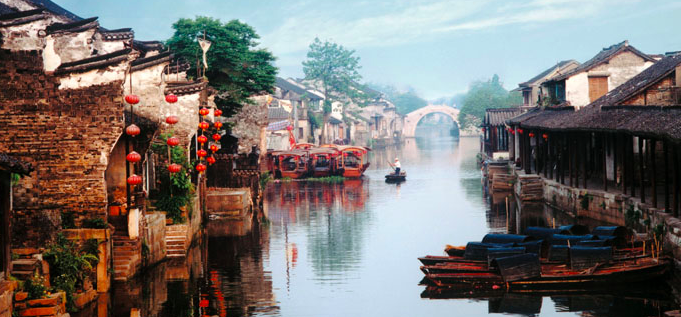Imagine wandering in one of the ink-colored Jiangnan water towns: you see a young girl gently holding her cyan paper umbrella. She walks slowly in the midst of stone bridges and observes water flowing down the river shores.
In the region south of the Yangtze, this is a very common scene, especially in the Zhejiang and Jiangsu provinces. For nearly 1000 years, these towns have been crucial trading hubs for the surrounding countryside.
Moreover, they possess an engaging history of architecture (dating back to the Ming and Qing dynasties), food (some of the most delicious in China!), arts and culture. Nowadays, very few of the river towns still exist, yet they remain the favorite places for famous writers to find inspiration.
Fortress Besieged, one of the masterpieces of the twentieth century in China by Qian Zhongshu, was written based on the scenes and daily stories in a small river town near Suzhou.
Here, we will take a look into the elegant yet fascinating world of Jiangnan water towns. I will also introduce you some symbolic scenes that charm the talented writers and artists to go.
-
1 Stone Bridges and Flowing Water 小桥流水
Solid bridges and slowly flowing rivers encompass the entire town. Around dusk, locals start cooking and smoke spirals up from their stoves. The mist of the river and smoke converge together in the sky harmoniously, creating a sense of fluidity. The little town brings about a scene of cozy, slow paced life, that you can easily immerse yourself in.
-
2 Tea House 茶楼
Any water town would be ashamed of itself if it did not have a historic tea house. “The First Tea House in Jiangnan” has a hundred year history. It attracts customers to its location, the North Street in Zhujiajiao, a townsite in the Qingpu District of Shanghai. The tea-drinkers sit with a cup of tea and look over the view of the pedestrians on the stone bridge, as well as the scenery of the sails on the river. Frequently, the owner of the tea house invites the artisans to play orchestral instruments made by bamboos on stage.
-
3 The Arts and Humanities Museum 人文艺术馆
At the museums in the water towns, you can find oil paintings, sculptures and other artistic pieces that showcase the town's local history, humanities, and folk customs. The topics of these museums often cover style, characters, and anecdotes of their folk history. It is a positive exploration of the town's combination of cultural and tourist attractions.
-
4 Dyeing Mill and Workshop 染坊
Dyeing is a traditional Chinese folk craftsmanship that has had a history of thousands of years. The technicians at mills in water towns pay close attention to pattern design, flower engraving, stenciling, and dyeing. The craftsmanship began with ancestors from the Song Dynasty. After enjoying the demonstration of the whole process you can bring some beautiful blue printed fabrics to home.
-
5 Musical Performances
The performance of “architectural music” is exclusively frome Zhujiajiao. It is a fascinating combination of architecture, running water, the Zen temple, and string music. The director, Tan Dun, chose the water town for his deep root to its waterscape and the people. “In the water music hall, music is visible, and architecture is also an instrument that can be played.” He said after a performance.








0 Comments